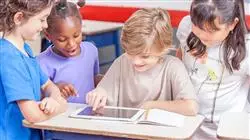University certificate
The world's largest faculty of education”
Description
Would you like to design a bilingual project for your pre-school and primary school students? Enroll in this Postgraduate diploma and you will be able to achieve it after 6 months of the best training 100% online"

The early mastery of English by the new generations has encouraged the inclusion of this language in the academic curriculum of the different subjects that make up the syllabus of pre-school and primary. In this way, from an early age, the development of a second language in addition to the vehicular language is promoted, taking advantage of the neurocognitive abilities that children possess to learn new languages. Currents such as ELF (English as a Lingua Franca) defend the empire of communication through language, beyond perfect pronunciation, enhancing language skills through games and innovative and dynamic teaching strategies, through which children get involved in teaching and enjoy learning.
It is precisely in this field that the Postgraduate diploma in English in the Bilingual Classroom is based, a multidisciplinary program that TECH and a team versed in Education have designed in order to share with teachers the guidelines for success in developing educational projects based on the promotion of the Anglo-Saxon language in a way combined with the mother tongue. In this way, and through 475 hours of 100% online education, the teacher will be able to delve into the keys and principles of bilingualism and L2 literacy, as well as the best strategies for the inclusion of English in the academic curriculum of Pre-school and Primary School. In addition, you will work intensively on the promotion of the four communication skills (reading, writing, speaking and listening) through the knowledge of the best.
You will have unlimited access to a state-of-the-art Virtual Campus where you will find, in addition to the syllabus, case studies to work on perfecting your skills and a variety of additional material presented in different audiovisual formats. In this way you will be able to expand each section in a personalized way, adapting the educational experience to your needs and requirements.. It is, therefore, an unique opportunity to raise your teaching quality to the highest level through the design of innovative bilingual projects at the forefront of English teaching in today's school environment. Because "a different language is a different vision of life".
The best program on the current academic market to work on your role as a bilingual teacher and on the improvement of your intercultural skills"
This Postgraduate diploma in English in the Bilingual Classroom contains the most complete and up-to-date educational program on the market. The most important features include:
- Practical cases presented by experts in bilingual education
- The graphic, schematic, and practical contents with which they are created, provide practical information on the disciplines that are essential for professional practice
- Practical exercises where the self-assessment process can be carried out to improve learning
- Its special emphasis on innovative methodologies
- Theoretical lessons, questions to the expert, debate forums on controversial topics, and individual reflection assignments
- Content that is accessible from any fixed or portable device with an Internet connection
The program delves into the best didactic strategies to establish fluid relations between L1 and L2 through the involvement of families in the bilingual project"
The program’s teaching staff includes professionals from the field who contribute their work experience to this educational program, as well as renowned specialists from leading societies and prestigious universities.
The multimedia content, developed with the latest educational technology, will provide the professional with situated and contextual learning, i.e., a simulated environment that will provide immersive education programmed to learn in real situations.
This program is designed around Problem-Based Learning, whereby the professional must try to solve the different professional practice situations that arise during the academic year For this purpose, the students will be assisted by an innovative interactive video system created by renowned and experienced experts.
You will be able to perfect your phonetic skills through a variety of practical exercises, both for your pronunciation and for working with children"

Do you know the Phonics method? Would you like to implement it in your classes? Then opt for a program like this one, which gives you the keys to develop the 5 communicative skills in a dynamic way"
Syllabus
TECH has included in the syllabus of this program 475 hours of the best theoretical, practical and additional content, which has been designed by the teaching team, following the guidelines of quality and completeness that define and differentiate this university from the rest. Thanks to this, it has been possible to create a Postgraduate diploma of the highest level, based on the most innovative guidelines for bilingual teaching in Pre-school and Primary School. In this way, teachers will be able to work 100% online to enhance their skills in multidisciplinary education through the knowledge of the most innovative didactic strategies in the current educational environment.

In the Virtual Campus you will find diverse additional material, in which didactic content has been included so that you can use it with the students in the bilingual classes that you will be able to design after the course of this program"
Module 1. Principles of Bilingualism
1.1. Definition and History of Bilingualism
1.1.1. Definition of Bilingualism
1.1.2. Languages in Contact
1.1.3. Definition of Multilingualism
1.1.4. Multilingualism in The World
1.1.5. Types of Multilingualism
1.2. Models of Bilingualism in Education
1.2.1. Bilingualism in Education
1.2.2. Models of Bilingual Education
1.2.3. Models of Bilingualism in the world
1.2.4. Bilingualism in Canada
1.2.5. Bilingualism in USA
1.2.6. Bilingualism in Spain
1.2.7. Bilingualism in Latin America
1.3. The Cultural Dimension of Bilingualism
1.3.1. Intercultural Bilingual Education (IBE)
1.3.2. The history of the EIB
1.3.3. Bilingualism and Cultural Diversity in the Classroom
1.3.4. Bilingualism and Cultural Identity
1.4. The Role of Native Language in Bilingual Education
1.4.1. Language Acquisition in the Bilingual Context
1.4.2. Late Bilingualism and The Mother Tongue
1.4.3. The Mother Tongue and Emotions
1.4.4. The Mother Tongue in the Classroom
1.4.5. Use of Mother Tongue in the Foreign Language Classroom
1.5. Neuroeducation and Bilingualism
1.5.1. Bilingual Brain
1.5.2. The Age Factor
1.5.3. The Quality Factor
1.5.4. The Method Factor
1.5.5. The Language Factor
1.5.6. The Number Factor
1.6. Cummins' Theories on Bilingualism
1.6.1. Introduction
1.6.2. Linguistic Interdependence Theory
1.6.3. The Threshold Hypothesis
1.6.4. Additive and Subtractive Bilingualism
1.6.5. The importance of the Mother Tongue
1.6.6. Language Immersion Programs
1.7. BICS and CALP
1.7.1. General Framework
1.7.2. Initial Theory
1.7.3. Definition of BICS
1.7.4. Definition of CALP
1.7.5. The Relationship between BICS and CALP
1.7.6. Contributions of the Theory
1.7.7. Criticisms of the Theory
1.8. Bilingualism in Pre-School
1.8.1. Languages in the Pre-School Syllabus
1.8.2. Myths about Bilingualism in Early Ages
1.8.3. The Place of the Second Language in the Pre-School Classroom
1.8.4. Routines
1.8.5. Working in Corners
1.8.6. Materials and Resources for Teaching English in Pre-School
1.9. Bilingualism in Primary School
1.9.1. Languages in the Primary SchoolSyllabus
1.9.2. Objectives of Bilingualism in Primary School
1.9.3. Bilingual Models in Primary School
1.9.4. Pros and Cons of Bilingualism in Primary School
1.9.5. The Role of the Environment in Success
1.10. The Role of the Bilingual Teacher
1.10.1. The Role of the Bilingual Teacher
1.10.2. The Bilingual Teacher as Intercultural Educator
1.10.3. Languages and the Bilingual Teacher
1.10.4. Training Needs
Module 2. Literacy in L2
2.1. Early Literacy in Bilingual Children
2.1.1. Definition of Initial Literacy: Growing Up in a Bilingual Family
2.1.2. Reading Stories in the Mother Tongue
2.1.3. Literacy in L2 as a Literate and Majority Language
2.1.4. Literacy in L2 as a Foreign Language
2.2. Influential Relationships between L1 and L2
2.2.1. Family Literacy
2.2.2. Mother Tongue Literacy in Schools
2.2.3. Impact of L1 Literacy o L2
2.2.4. Advantages of Using the Mother Tongue in the Bilingual Classroom
2.2.5. The Mother Tongue in Teaching English
2.3. Approaches to Literacy in English
2.3.1. Theories of Written Language Acquisition
2.3.2. Theories about Literacy in L2
2.3.3. Multiple Literacies
2.3.4. English as L2 Literacy Methods
2.4. English Phonetics
2.4.1. What is Phonetics?
2.4.2. The Role of Phonics in L2 Learning
2.4.3. Characteristics of English Phonetics
2.4.4. Phonetics or Phonology for the English Classroom
2.5. Synthetic Method: phonemic awareness
2.5.1. Definition of Phonological and Phonemic Awareness
2.5.2. Phonemic Awareness and the Learning of English as a L2
2.5.3. How to Work at Home
2.5.4. How to Work in the Classroom
2.6. Synthetic Method: Phonics
2.6.1. Characteristics of the Phonics Method
2.6.2. Introduction to Jolly PhonicsMethod
2.6.3. The Five Skills that are Worked on
2.6.4. Materials and Resources
2.6.5. Other Resources Phonics Readers, Videos, Songs, etc.
2.7. Globalized Reading “Whole Language”
2.7.1. Principles of a Globalised Approach
2.7.2. Chomsky and Goodman
2.7.3. Implications for Teaching English as an L2
2.7.4. Activities and Resources
2.7.5. The Concept of "Integrated Literacy” Balanced Literacy
2.8. Working with Graded Readers
2.8.1. Definition of Reader and Characteristics
2.8.2. Advantages of Extensive Reading
2.8.3. Strategies for the Use of Readers in the Classroom
2.8.4. Activities with Readers in the Classroom
2.9. Picture Books
2.9.1. Reasons for Using Storytelling in the Classroom
2.9.2. Definition and Characteristics of an Illustrated Album
2.9.3. Selection Criteria
2.9.4. Activities and Strategies of Use
2.9.5. Classic Picture Books of English Literature
2.10. Storytelling Oral Narration
2.10.1. Oral Narration in the Classroom
2.10.2. Reading or Telling a Story
2.10.3. Oral Narration as an L2 Teaching Tool
2.10.4. Keys to Oral Narration
2.10.5. Activities for Before, During, and After the Oral Narration
2.10.6. Collective Oral Narration
Module 3. English in the Bilingual Classroom
3.1. L2 Learning. Methods and Approaches
3.1.1. From Grammar to Communication
3.1.2. Grammar-Translation Method
3.1.3. Natural Method
3.1.4. Total Physical Response
3.1.5. Audio-Lingual Method
3.1.6. Suggestopedia
3.1.7. Communicative Approach
3.2. L2 Learning at an Early Age (0-6)
3.2.1. Myths and Facts about Early L2 Learning
3.2.2. The Age Factor in L2 Learning
3.2.3. Benefits of Early L2 Acquisition
3.2.4. Stages of the Early L2 Acquisition
3.2.5. Relations with Families
3.2.6. Benefits of Early L2 Acquisition
3.3. L2 and Interaction
3.3.1. The Role of Interaction in Learning
3.3.2. Interaction in Native Language Learning
3.3.3. Interaction in L2 Learning
3.3.4. Types of Interaction in the Foreign Language Classroom
3.3.5. Teacher Talking Time
3.4. The Role of Emotions in L2 Learning
3.4.1. Emotions and Learning
3.4.2. The Theory of Output
3.4.3. How Anxiety Affects
3.4.4. Emotions and Trust
3.4.5. Motivation
3.5. English Communication Skills
3.5.1. The Integration of Communicative Skills
3.5.2. MECRL. Common European Framework of Reference for Languages
3.5.3. Levels of Reference
3.6. Listening
3.6.1. Definition of Listening
3.6.2. Techniques and Tools for Teaching Listening
3.6.3. Activity Examples
3.6.4. Before the Activity
3.6.5. During the Activity
3.6.6. After the Activity
3.7. Reading
3.7.1. Definition of Reading
3.7.2. Techniques and Tools for Teaching Reading
3.7.3. Activity Examples
3.7.4. Before the Activity
3.7.5. During the Activity
3.7.6. After the Activity
3.8. Speaking
3.8.1. Definition of Speaking
3.8.2. Techniques and Tools for Teaching Speaking
3.8.3. Activity Examples
3.8.4. Before the Activity
3.8.5. During the Activity
3.8.6. After the Activity
3.9. Writing
3.9.1. Definition of Writing
3.9.2. Techniques and Tools for Teaching Writing
3.9.3. Activity Examples
3.9.4. Before the Activity
3.9.5. During the Activity
3.9.6. After the Activity
3.10. Assessment
3.10.1. How to Evaluate Listening
3.10.2. How to Evaluate Reading
3.10.3. How to Evaluate Speaking
3.10.4. How to Evaluate Writing

This academic itinerary is exclusive to TECH and you will be able to develop it at your own pace thanks to its 100% online Relearning methodology"
Postgraduate Diploma in English in the Bilingual Classroom
Prepare yourself to boost your teaching skills and enhance English language learning in the bilingual classroom with our Postgraduate Diploma in English in the Bilingual Classroom. At TECH Global University, we offer you a unique opportunity to acquire the knowledge and skills necessary to provide quality education in a bilingual environment. Our online classes will allow you to study in a flexible and convenient way, adapting to your schedule and without geographical restrictions. At TECH Global University, we understand the importance of the online modality to access quality education and expand your knowledge without limitations. By joining our program, you will immerse yourself in the latest methodologies and pedagogical approaches to teach English in the bilingual classroom. You will learn effective strategies to promote oral and written communication in English, as well as innovative techniques to foster students' active participation and linguistic development.
You will also learn about the latest methodologies and pedagogical approaches for teaching English in the bilingual classroom.
Specialize in teaching English
In this postgraduate course you will explore digital resources and technological tools that will help you enrich your classes and create interactive and motivating learning environments. You will discover how to effectively integrate technology to facilitate English language learning and enhance your students' language skills. Our program will provide you with a solid theoretical and practical foundation in teaching English as a foreign language. You will learn about language acquisition, learning assessment, instructional materials design and classroom management in a bilingual context. You will obtain the necessary tools to face the challenges of teaching English in a multicultural environment. Become a benchmark in bilingual education and boost your teaching career with TECH Global University's Postgraduate Diploma program in English in the Bilingual Classroom. Join our educational community and take advantage of the benefits of online classes to expand your knowledge and transform your teaching practice.







